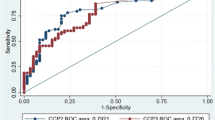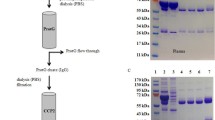Abstract
To investigate the prevalence of anti-third generation cyclic citrullinated peptide antibodies (anti-CCP3) in patients with systemic connective tissue diseases, we assembled a training set consisting of 115 patients with rheumatoid arthritis (RA), 52 with Calcinosis, Raynaud’s phenomenon, oesophageal dysmotility, sclerodactyly, telangiectasia (CREST) syndrome, 21 with scleroderma, 20 with ankylosing spondylitis, 18 with reactive arthritis, 25 with juvenile rheumatoid arthritis (RA), 51 with osteoarthritis, 26 with mixed connective tissue disease, 23 with primary Sjogren’s syndrome, 74 with systemic lupus erythematosus, 49 with Polymyaglia rheumatica, and 39 with polymyositis/dermatomyositis. The commercial enzyme-linked immunosorbent assay (ELISA) was used to detect anti-CCP antibodies, including anti-CCP2 (regular, second generation of CCP antigen) and anti-CCP3 (third generation of CCP antigen) in disease-related specimens and normal controls. These serum samples were also evaluated for anti-centomere antibodies by anti-centromere ELISA kit. The higher frequencies of anti-CCP3 and anti-CCP2 were detected in 75.6 and 70.4% patients with RA, respectively. At the same time, anti-CCP3 (not anti-CCP2) was significantly increased in samples isolated from patients with CREST syndrome. The clinical sensitivity of IgG anti-CCP3 for the patients with CREST syndrome was 29% (15 of 52) and the specificity was 96% (384 of 397), with the exception of the RA group. The anti-centromere antibodies were significantly higher in patients with CREST only. The results of our study suggest that compared to anti-CCP2 assay, the new anti-CCP3 assay can enhance the clinical sensitivity for diagnosis of RA and, as an associate marker combined with anti-centromoere, can distinguish CREST syndrome from other systemic connective tissue diseases, especially RA. The clinical specificity of anti-CCP3 was lower than anti-CCP2 assay in diagnosis of RA because of the crossreaction to the patients with CREST syndrome.
Similar content being viewed by others
References
Von Muhien, and Tan, E. M. (1995). Antoantibodies in the diagnosis of systemic rheumatic diseases. Semin Arthritis Rheum, 24, 323–358.
Senshu, T., Kan, S., Ogawa, H., Manabe, M., and Asaga, H. (1996). Preferential deimination of keratin K1 and filaggrin during the terminal differentiation of human epidermis. Biochem Biophys Res Commun 225, 712–719.
Vossenaar, E. R., Zendman, A. J., van Venrooij, W. J., Pruijn, G. J., (2003), PAD, a growing family of citrullinating enzymes: genes, features and involvement in disease. Bioassays 25, 1106–1118.
ACR Subcommittee on RA Guidelines (2002), Guidelines for the management of rheumatoid arthritis. Arthritis Rheum 46, 328–346.
Goldbach-Mansky, R., Lee, J., McCoy, A., et al. (2000), Rheumatoid arthritis associated autoantibodies in patients with synovitis of recent onset. Arthritis Res 2, 236–243.
Schellekens, G. A., de Jong, B. A., van den Hoogen, F. H., van de Putte, L. B., and van Venrooij, W. J. (1998), Citrulline is an essential constituent of antigenic determinants recognized by rheumatoid arthritis-specific autoantibodies. J Clin Invest 101, 273–281.
Schellekens, G. A., Visser, H., de Jong, B. A., et al. (2000), The diagnostic properties of rheumatoid arthritis antibodies recognizing a cyclic citrullinate peptide. Arthritis Rheum 43, 155–163.
Nielen, M. M., van Schaardenburg, D., Reesink, H. W., et al. (2004), Specific autoantibodies precede the symptoms of rheumatoid arthritis: a study of serial measurements in blood donors. Arthritis Rheum 50, 380–386.
Rantapaa-Dahlqvist, S., de Jong, BA, Berglin, E., et al. (2003), Antibodies against cyclic citrullinated peptide and IgA rheumatoid factor predict the development of rheumatoid arthritis. Arthritis Rheum 48, 2741–2749.
Suzuki, K., Sawada, T., Murakami, A., et al. (2003), High diagnostic performance of ELISA detection of antibodies to citrullinated antigens in rheumatoid arthritis. Scand J Rheumatol 32, 197–204.
Agrawal, S., Misra, R., and Aggarwal, A. (2007), Autoantibodies in rheumatoid arthritis: association with severity of disease in established RA. Clin Rheumatol 26, 201–204.
Shovman, O., Gilburd, B., Zandman-Goddard, G., et al. (2005), The diagnostic utility of anti-cyclic circullinated peptide antibodies, matrix metalloproteinase-3, rheumatoid factor, erythrocyte sedimentation rate, and C-reactive protein in patients with erosive and non-erosive rheumatoid arthritis. Clin Dev Immunol 12, 197–202.
Vencovsky, J., Machacek, S., Sedova, L., et al. (2003), Autoantibodies can be prognostic markers of an erosive disease in early rheumatoid arthritis. Ann Rheum Dis 62, 427–430.
Meyer, O., Labarre, C., Dougados, M., et al. (2003), Anticitrullinated protein/peptide antibody assays in early rheumatoid arthritis for predicting five year radiographic damage. Ann Rheum Dis 62, 120–126.
Forslind, K., Ahlmen, M., Eberhardt, K., et al. (2004), Prediction of radiological outcome in early rheumatoid arthritis in clinical practice: role of antibodies to citrullinated peptides (anti-CCP). Ann Rheum Dis 63, 1090–1095.
Visser, H., le Cessie, S., Vos, K., Breedveld, F. C., and Hazes, J. M. (2002), How to diagnose rheumatoid arthritis early: a prediction model for persistent (erosive) arthritis. Arthritis Rheum, 4, 357–365.
Orbach, H., Gilburd, B., Brickman, C., Gerli, R., and Shoenfeld, Y. (2002), Anti-cyclic peptide antibodies as a diagnostic test for rheumatoid arthritis and predictor of an erosive disease. IMAJ 4, 892–893.
Baeten, D., Peene, I., Union, A., et al. (2001), Specific presence of intracellular citrullinated proteins in rheumatoid arthritis synovium: relevance to antifilaggrin autoantibodies. Arthritis Rheum, 44, 2255–2262.
van Boekel, M. A., Vossenaar, E. R., van den Hoogen, F. H., van Venrooij, W. J. (2002), Autoantibody systems in rheumatoid arthritis: specificity, sensitivity and diagnostic value. Arthritis Res 4, 87–93.
Vossenaar, E. R. and van Venrooij, W. J. (2004) Anti-CCP antibodies, a specific marker for (early) rheumatoid arthritis. Clin Appl Immunol Rev 4, 239–262.
Vallbracht, I., Rieber, J., Oppermann, M., Forger, F., Siebert, U., and Helmke, K. (2004), Diagnostic and clinical value of anti-cyclic citrullinated peptide antibodies compared with rheumatoid factor isotypes in rheumatoid arthritis. Ann Rheum Dis 63, 1079–1084.
Bas, S., Genevay, S., Meyer, O., and Gabay, C. (2003), Anti-cyclic citrullinated peptide antibodies, IgM and IgA rheumatoid factors in the diagnosis and prognosis of rheumatoid arthritis. Rheumatology (Oxford) 42, 677–680.
van Jaarsveld, C-.H., ter Borg, E. J., Jacobs, J. W., et al. (1999), The prognostic value of the antiperinuclear factor, anti-citrullinated peptide antibodies and rheumatoid factor in early rheumatoid arthritis. Clin Exp Rheumatol. 17, 689–697.
Saraux, A., Berthelot, J. M., Devauchelle, V., et al. (2003), Value of antibodies to citrulline-containing peptides for diagnosing early rheumatoid arthritis. J Rheumatoln 30, 2535–2539.
Vittecoq, O., Incaurgarat, B., Jouen-Beades, F., et al. (2004), Autoantibodies recognizing citrullinated rat filaggrin in an ELISA using citrullinated and non-citrullinated recombinant proteins as antigens are highly diagnostic for rheumatoid arthritis. Clin Exp Immunol 135, 173–180.
Arnett, F. C., Edworthy, S. M., Bloch, D. A., et al. (1988), The American Rheumatism Association 1987 revised criteria for the classification of rheumatoid arthritis. Arthritis Rheum 31, 315–324.
Zeng, X., Ai, M., Tian, X., et al. (2003), Diagnostic value of anti-cyclic citrullinated Peptide antibody in patients with rheumatoid arthritis. J Rheumatol 30, 1451–1455.
Mediwake, R., Isenberg, D. A., Schellekens, G. A., and van Venrooij, W. J. (2001), Use of anti-citrullinated peptide and anti-RA33 antibodies in distinguishing erosive arthritis in patients with systemic lupus erythematosus and rheumatoid arthritis. Ann Rheum Dis 60, 67–68.
Lopez-Hoyos, M., Ruiz de Algegria, C., Blanco, R., et al. (2004), Clinical utility of anti-CCP antibodies in the differential diagnosis of elderly-onset rheumatoid arthritis and polymyalgia rheumatica. Rheumatology (Oxford) 43, 655–657.
Gottenberg, J. E., Mignot, S., Nicaise-Rolland, P., et al. (2005), Prevalence of anti-cyclic citrullinated peptide and anti-keratin antibodies in patients with primary Sjogren’s syndrome. Ann Rheum Dis 64, 114–147.
Kamali, S., Polat, N. G., Kasapoglu, E., et al. (2005), Anti-CCP and antikeratin antibodies in rheumatoid arthritis, primary Sjogren’s syndrome, and Wegener’s granulomatosis. Clin Rheumatol 24, 673–676.
Alenius, G. M., Berglin, E., Rantapaa Dahlqvist, S., (2006), Antibodies against cyclic citrullinated peptide (CCP) in psoriatic patients with or without joint inflammation. Ann Rheum Dis 65, 398–400.
Vossenaar, E. R., Smeets, T. J., Kraan, M. C., Raats, J. M., van Venrooij, W. J., and Tak, P. P. (2004), The presence of citrullinated proteins is not specific for rheumatoid synovial tissue., Arthritis Rheum 50, 3485–3494.
Fritzler, M. J., and Kinsella, T. D. (1980), The CREST syndrome: a distinct serologic entity with anticentromere antibodies. Am J Med 69, 520–526.
Weiner, E. S., Earnshaw, W. C., Senecal, J. L., Bordwell, B., Johnson, P., and Rothfield, N. F. (1988), Clinical associations of anticentromere antibodies and antibodies to topoisomerase I. A study of 355 patients. Arthritis Rheum 31, 378–385.
Tan, E. M., Rodnan, G. P., Garcia, J., Moroi, Y., Fritzler, M. J., and Peebles, C. (1980), Diversity of antinuclear antibodies in progressive systemic sclerosis. Anti-centromere antibody and its relationship to CREST syndrome. Arthritis Rheum 23, 617–625.
Caramaschi, P., Biasi, D., Manzo, T., Carletto, A., Poli, F., and Bambara, L. M. (1995), Anticentromere antibody—clinical associations. A study of 44 patients. Rheumatol of Int 14, 253–255.
Zuber, M., Gotzen, R., Filler, I. (1994), Clinical correlation of anticentromere antibodies. Clin Rheumatol 13, 427–432.
Miyawaki, S., Asanuma, H., Nishiyama, S., and Yoshinaga, Y. (2005), Clinical and serological heterogeneity in patients with anticentromere antibodies. J Rheumatol 32, 1488–1494.
Author information
Authors and Affiliations
Rights and permissions
About this article
Cite this article
Wu, R., Shovman, O., Zhang, Y. et al. Increased Prevalence of Anti-Third Generation Cyclic Citrullinated Peptide Antibodies in Patients With Rheumatoid Arthritis and CREST Syndrome. Clinic Rev Allerg Immunol 32, 47–55 (2007). https://doi.org/10.1007/BF02686081
Issue Date:
DOI: https://doi.org/10.1007/BF02686081




